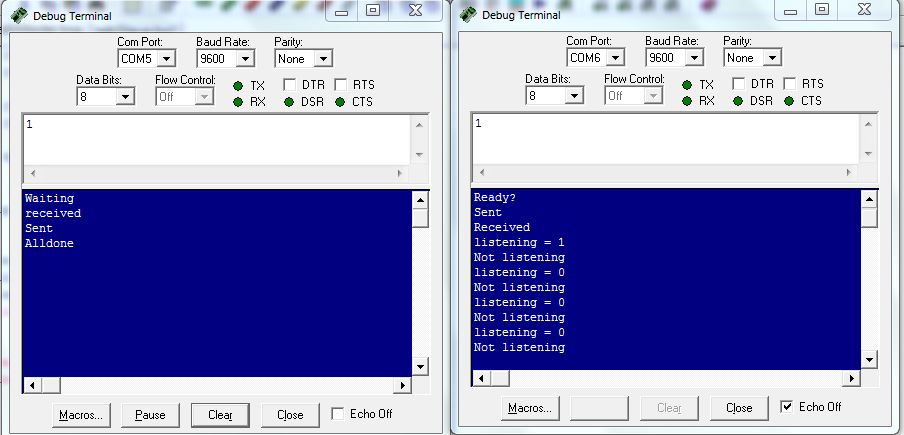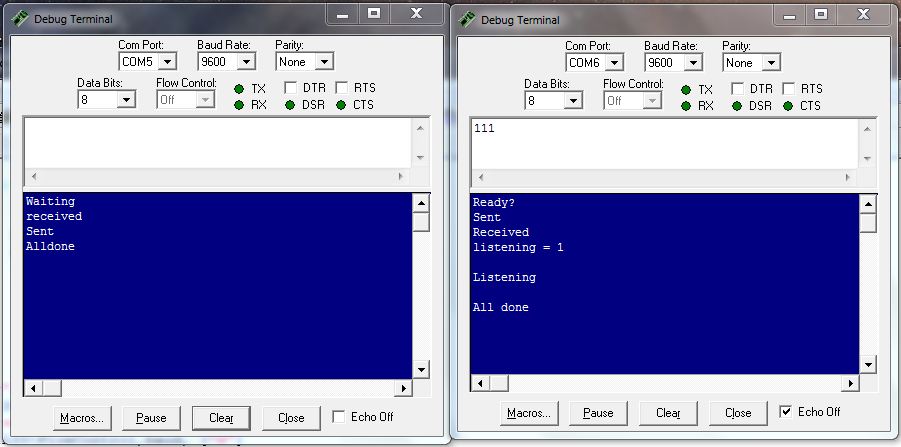PBASIC Question
I'm new to robotics. It was something I wanted to do as a kid but wasn't able to until now. I stumbled across the BOE-BOT a couple of months ago and fell in love.
My little creation consists of a bsp24 master and bs2 slave. The slave controls a soundPal, a servoPal, wheel encoders, an accelerometer, and 4 QTI sensors. The master controls, at the moment, a temperature sensor and a serial LCD. The master also controls a Ping sensor, photo resistor, ir detector, and ir LED mounted on a turret.
I have both master and slave reliably doing what they need to be doing.
I also have master and slave passing commands and responses as they should, not so reliably.
While working on the communication problem I came across a programming thing that drove me nuts for a bit.
Why does this work...
IF listening = no THEN
but not this...
IF NOT listening THEN
listening is a bit
yes = 1, no = 0
Am I missing something, (won't be the first time)??????
I've attached the code and some screen shots of the output.
Thanks,
Rick.
My little creation consists of a bsp24 master and bs2 slave. The slave controls a soundPal, a servoPal, wheel encoders, an accelerometer, and 4 QTI sensors. The master controls, at the moment, a temperature sensor and a serial LCD. The master also controls a Ping sensor, photo resistor, ir detector, and ir LED mounted on a turret.
I have both master and slave reliably doing what they need to be doing.
I also have master and slave passing commands and responses as they should, not so reliably.
While working on the communication problem I came across a programming thing that drove me nuts for a bit.
Why does this work...
IF listening = no THEN
but not this...
IF NOT listening THEN
listening is a bit
yes = 1, no = 0
Am I missing something, (won't be the first time)??????
I've attached the code and some screen shots of the output.
Thanks,
Rick.





Comments
IF NOT listening THEN
' do something
ENDIF
IF listening = 1 THEN
' do something
ENDIF
listening = ~listening
IF listening THEN
' do something
ENDIF
Thanks for the reply.
I realize that what you say is true and that is what I expected to happen.
Unfortunately that is not what my code actually does. If you look at the code snippets I attached and the screen shots of the output you'll see that even with listening = 1, the if decision still falls through.
Is it a bug in the code or something about the way I am using it? I've looked at it for too long. I need some new eyes to take a look.
Whether you realize it or not, all evaluations in Pbasic take place in a "hidden" 16 bit work space, then the evaluation(s) are performed, then the results (if any, like in a math operation) are moved back into whatever variable space you've assigned.
A simple example:
x VAR Byte
y VAR Byte
z VAR Byte
z = x + y
You would "think" that it adds bytes and then you've got your Z byte. But it doesn't. The Stamp first converts each value to the right of the = into "Words", then does the math, then converts back to a byte for the Z val. Most of the time this is invisible and is fine (it's also how you can do things like z = x + y MAX 255 without worrying about "rollover" in the x + y byte addition).
So in the case of NOT and other LOGICAL operations (rather than the binary operators like ^ & | ~), if you have bit only values you could get unexpected results:
x VAR Bit
x = 1
NOT x
In the above, when X is "moved" into Word space, you get %0000000000000001, then you NOT it and the result is %1111111111111110. If the end of your evaluation is to reassign that internal Word to the bit, you'll get the 1 you expect, but if you check the result in an evaluation (say, IF THEN), then a simple 1 or 0 or true or false won't work because %1111111111111110 does not equal 0, but rather -1.
And lo, in the Stamp manual it discusses this very "trap" on page 224 of manual version 2.1:
IF ( NOT listening & %1 ) THEN
' do something
ENDIF
And who reads documentation anyway?
Thanks.